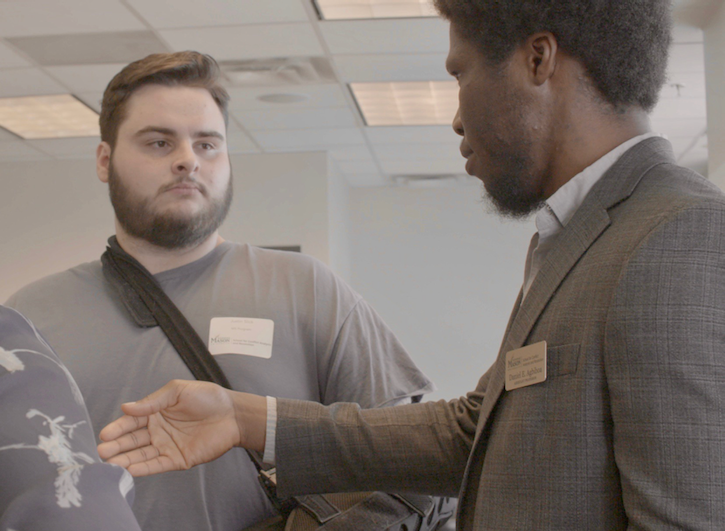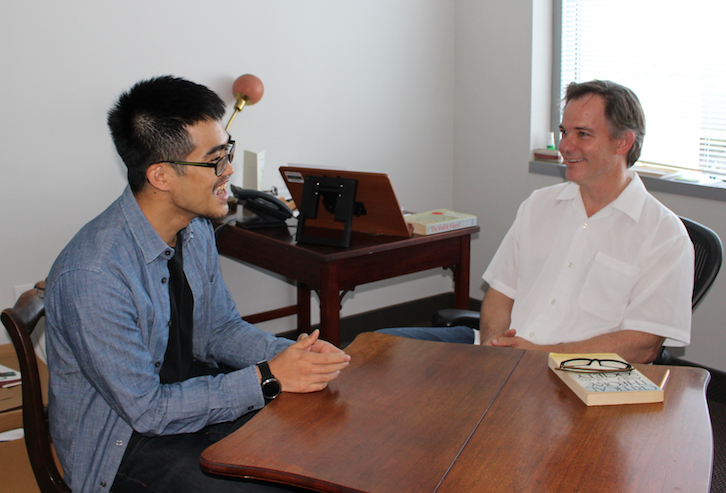
Justin Slick (left), a member of the Carter School's incoming Fall 2018 master’s program cohort, chats with his faculty mentor, Daniel Agbiboa (right), formerly an assistant professor at the Carter School, during the graduate student orientation on August 23, 2018.
When Justin Slick sat down in February 2018 for his first meeting with Charisse Cardenas, the Graduate Academic Advisor for the Jimmy and Rosalynn Carter School for Peace and Conflict Resolution (formerly S-CAR), he was already “fairly set” on applying to the school’s Master of Science program.
Then he heard that the Carter School was planning to introduce concentrations for its master’s students.
“It definitely made me more excited about applying and made me want to get in that much more,” said Slick, who is now in his first semester as an MS student.
Carter School master’s students have the option to specialize in one of six areas of focus: 1) Social Justice Advocacy and Activism; 2) Dynamics of Violence; 3) Inclusive Conflict Engagement; 4) Conflict-Sensitive Development and Resilience; 5) Media, Narrative, and Public Discourse; and 6) Peacebuilding.
MS students also have the option to create an individualized concentration to gain subject-matter expertise that does not neatly fit into one of the pre-designed concentrations.
The introduction of the concentrations is part of a multi-year effort to evaluate Carter School’s master’s program and develop opportunities to equip students with the theoretical tools and practical training needed to help them push the field of conflict analysis and resolution forward.
This effort began with an updated curriculum that reduced the number of credits that students must take from 42 to 33. Agnieszka Paczynska, director of the master’s program, said that the reduction was meant in part to make the program more affordable in a time of rising student debt and wage stagnation, while still maintaining the program’s rigor.
Within this new curriculum, students take 15 credit hours of required courses, 9 credit hours of a concentration, and 9 credit hours of electives.
Students who wish to do so may theoretically use their final nine elective credits to declare a second concentration. The Carter School is currently working with the Registrar’s Office to confirm whether formal recognition of more than one concentration on students’ degrees is possible.
According to Paczynska, the concentrations will give students the chance to chart “pathways through the program that make the most sense to them.”
These formal concentrations also reflect a broader shift in the field of conflict analysis and resolution from generalization toward specialization.
“Although conflict resolution is more established now than it was previously, it’s still an emerging field,” said Cardenas, who is also an MS alumna. “Part of our responsibility as being the institution [that has] essentially developed the field of conflict resolution and analysis is…to understand where the field is going.”
The specializations offered by the Carter School were developed from a “juncture of the expertise that’s here and what we saw as student interest, based on conversations with alumni and students, as well as what we saw as really exciting developments out in the world,” said Paczynska.
One of these exiting developments is reflected in the Conflict-Sensitive Development and Resilience (CSDR) concentration, which arose in part from “the recognition that this is something that has become incredibly important across various donor agencies [and] nongovernmental organizations working on issues of peacebuilding and development,” according to Paczynska.
She said that the concentration will help students to engage with questions like what it means to do conflict-sensitive programming and how to translate knowledge from fields like peacebuilding and development to individuals outside of these fields, such as those working on anti-malaria campaigns or developing power grids.
Meanwhile, students who decide on the Media, Narrative, and Public Discourse (MNPD) concentration will learn narrative approaches to conflict while gaining exposure to the use of narratives in practices like media, government, and therapeutic work, among other areas.
“We’re really interested in taking some of these philosophical insights and turning them towards practical outcomes,” said Solon Simmons, a Carter School associate professor who worked closely with Sara Cobb, the Druscilla French Cumbie Professor at the school, to develop the MNPD concentration.
Students in the Dynamics of Violence (DYNV) concentration will be given a deep understanding of the “sources of destructive violence, whether that’s at the interpersonal level, the community level, or the international global level,” said Douglas Irvin-Erickson, a Carter School assistant professor. “The goal of the concentration is to diminish violence and the impact of violence in our lives.”
The development of all of the concentrations drew on the Carter School’s unique blend of theory and practice to connect students’ interests with the frameworks and skills needed to pursue them.
For example, the Social Justice Advocacy and Activism (SJAA) concentration was developed because “[w]e felt there was quite a lot of interest among people interested in social justice issues, which we are interested in, to acquire more tools to be able to more effectively engage in advocacy,” according to Paczynska. The SJAA concentrations draws on the work of the Carter School’s faculty to equip students with these tools.
Whichever concentrations students choose, the idea is to give them “a chance to develop a coherent set of approaches and skills” tied directly to their personal, professional, and academic interests, according to Irvin-Erickson.
Cardenas said that faculty members were “mindful and thoughtful” about students’ possible next steps after the Carter School when crafting these areas of specialization. “These concentrations have been created with particular institutions and careers in mind,” she said.
There are also intersections between the concentrations, allowing students to build diverse sets of skills and approaches through the Carter School's robust curriculum, regardless of which concentrations they choose.
For example, Narrative Approaches to Conflict Analysis (CONF 704) feeds into both the MNPD concentration and the Inclusive Conflict Engagement (ICEN) concentration, the latter of which “prepares students for working to resolve conflicts and address divided cultures, societies, and organizations as advocates, mediators, peace-builders, and insider-partials,” according to the concentrations catalogue. ICEN students will also build “an intersectional awareness of diversity.”
The course overlap between the concentrations means that students will be able to build synergies with fellow students and faculty from a broad range of disciplines and subject-matter expertise while still being able to build their own specializations.
For Slick, the ability to specialize is key to his career goals. As someone who hopes to work in the intelligence community, Slick wants to declare two concentrations: Dynamics of Violence, to help him understand how terrorist groups are formed and become successful; and Media, Narrative, and Public Discourse, to help him understand how to counter these groups’ narratives and recruitment.
“This can set me up for a better level of success in the future in having this background knowledge and being able to really have a concise concentration that I can…fully express during an interview, or put on my resume,” said Slick.
Students in the Fall 2018 cohort will be expected to declare their concentrations at the beginning of their second semester, while master’s students who began coursework before Fall 2018 still have the option to switch to the concentrations track.
According to Cardenas, many students are making the switch, and one student has already had an individualized concentration proposal approved.
For Cardenas, the inclusion of an individualized concentration option underlines the Carter School’s commitment to enabling students “to continue to be on the cutting edge” of the field.
“We’ve already had the reputation of being interdisciplinary. We’ve already had the reputation of a sound theoretical-practice-driven institution. Now we have the opportunity of being able to declare specializations and being able to [formally] develop a depth of expertise,” she said.
“That’s taken the best of what we do and [is] really setting students up for a different level of success.”

